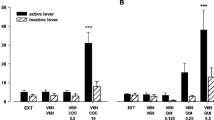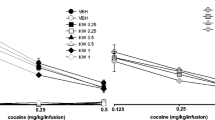Abstract
The effect of centrally and peripherally administered dopamine D1 and D2 specific compounds on core body temperature in mice was investigated. Quinpirole (LY-17155), a D2 agonist, induced a dose-dependent fall in body temperature (2.4–11.6%; p<0.003) when injected intraperitoneally (ip, 0.3–3.0 mg/kg) and intracerebroventricularly (icv, 0.1 mg/kg). This quinpirole-induced (1.0 mg/kg, ip) hypothermia was reversed by the central and peripheral administration of the D2 antagonists S-(−)-sulpiride (3.0–30.0 mg/kg, ip; 0.1–3.0 mg/kg, icv) and spiperone (0.03 and 0.1 mg/kg, ip; 0.03–3.0 mg/kg, icv). Domperidone, a D2 antagonist which does not cross the blood brain barrier, had no effect on quinpirole-induced hypothermia (1.0–10.0 mg/kg, ip). Domperidone partially reversed quinpirole-induced hypothermia at 0.1–30.0 mg/kg, icv. The D1 agonist, SKF-38393 at a high dose of 10.0 mg/kg, ip mildly attenuated quinpirole-induced hypothermia (a 1.8% increase in temperature). SKF-38393 at 10.0 mg/kg, icv potentiated quinpirole-induced hypothermia. SCH-23390 (0.1–3.0 mg/kg, ip), a D1 antagonist, had no effect on quinpirole-induced hypothermia and potentiated the hypothermia when administered icv. An ineffective icv dose of spiperone (0.01 mg/kg) in reversing quinpirole-induced hypothermia was rendered effective by prior administration of SCH-23390 (0.1–3.0 mg/kg, icv) but not by SKF-38393 (1.0–10.0 mg/kg, icv). These data suggest a central D2 receptor mechanism mediating hypothermia in mice which is capable of being modulated by the D1 receptor.
Similar content being viewed by others
References
Hornykiewicz, O. 1986. A quarter century of brain dopamine research. Pages 3–18,in Woodruff, G. N., Poat, J. A., and Roberts, P. J. (eds.). Dopaminergic systems and their regulation. VCH Publishers, Florida.
Kebabian, J. W., and Calne, D. B. 1979. Multiple receptors for dopamine. Nature 277:93–96.
Sokoloff, P., Giros, B., Martres, M. P., Bouthenet, M. L., and Schwartz, J. C. 1990. Molecular cloning and characterization of a novel dopamine receptor (D3) as a target for neuroleptics. Nature 347:146–151.
Pendleton, R. G., Samler, L., Kaiser, C., and Ridley, P. T. 1978. Studies on renal dopamine receptors with a new agonist. European Journal of Pharmacology 51:19–28.
Tsuruta, K., Frey, E. A., Grewe, C. W., Cote, T. E., Eskay, R. L., and Kebabian, J. W. 1981. Evidence that LY-141865 specifically stimulates the D2 dopamine receptor. Nature 292:463–465.
Iorio, L. C., Barnett, A., Letiz, F. H., Houser, V. P., and Korduba, C. A. 1983. SCH 23390, a potential benzapine antipsychotic with unique interactions of dopaminergic systems. The Journal of Pharmacology and Experimental Therapeutics 226:462–468.
Molloy, A. G., and Waddington, J. L. 1984. Dopaminergic behavior sterospecifically promoted by the D1 agonist R-SK&F 38393 and selectively blocked by the D1 antagonist SCH 23390. Psychopharmacology 82:409–410.
Starr, B. S., and Starr, M. S. 1986. Differential effects of dopamine D1 and D2 agonists and antagonists on velocity of movement, rearing and grooming in the mouse. Neuropharmacology 25:455–463.
Cross, A. J., Crow, T. J., and Owen F. 1986. Post-mortem studies of dopaminergic function in schizophrenia. Pages 273–284,in Woodruff, G. N., Poat, J. A., and Roberts, P. J. (eds.) Dopaminergic systems and their regulation. VCH Publishers, Florida.
Puglisi-Allegra, S., and Cabib, S. 1987. The D2 dopamine receptor agonst LY171555 induces catalepsy in the mouse. Pharmacology biochemistry & Behavior 30:765–758.
Mailman, R. B., Schulz, D. W., Lewis, M. H., Staples, L., Rollema, H., and DeHaven, D. L. 1984. SCH-23390: A selective D1 dopamine antagonist with potent D2 behavioral actions. European Journal of Pharmacology 101:159–160.
Arnt, J., Hyttel, J., and Perregaard, J. 1987. Dopamine D-1 receptor agonists combined with selective D-2 agonist quinpirole facilitate the expression of oral stereotyped behavior in rats. European Journal of Pharmacology. 133:137–145.
Moore, N. A., and Axton, M. S. 1988. Production of climbing behaviour in mice requires both D1 and D2 receptor activation. Psychopharmacology 94:263–266.
Gershanik, M. D., Heikkila, R. E., and Duvoisin, R. C. 1983. Behavioral correlations of dopamine receptor activation. Neurology 33:1489–1492.
Smith, F. L., St. John, C., Yang, T. F., and Lyness, W. H. 1989. Role of specific dopamine receptor subtypes in amphetamine discrimination. Psychopharmacology 97:501–506.
Cox, B., and Lee, T. F. 1977. Do central dopamine receptors have a physiological role in thermoregulation? British Journal of Pharmacology 61:83–86.
Koller, W., Herbster, G., Anderson, D., Wack, R., and Gordon, J. 1987. Quinpirole hydrochloride, a potential anti-Parkinsonism drug. Neuropharmacology 26:1031–1036.
Faunt, J. E., and Crocker, A. D. 1987. The effects of selective dopamine receptor agonists and antagonists on body temperature in rats. European Journal of Pharmacology 133:243–247.
Menon, M. D., Gordon, L. E., Kodama, C. K., and Fitten, J. 1988. Influence of D1 receptor system on the D2 receptor-mediated hypothermic response in mice. Life Sciences 43:871–881.
Axton, M. S., and Moore, N. A. 1987. Apomorphine-induced behavior in mice: A D1 and D2 dopamine receptor interaction. British Journal of Pharmacology 90:238.
Chipkin, R. E. 1988. Effects of D1 and D2 antagonists on basal and apomorphine decreased body temperature in mice and rats. Pharmacology Biochemistry & Behavior 30:683–686.
Sanchez, C. 1989. The effects of dopamine D-1 and D-2 receptor agonists on body temperature in male mice. European Journal of Pharmacology, 171:201–206.
Laduron, P. M., and Leysen, J. E. 1979. Domperidone, a specific in vitro dopamine antagonists, devoid of in vivo dopaminergic activity. Biochemical Pharamacology 28:2161–2165.
Palacios, J. M., Niehoff, D. L., and Kuhar, M. J. 1981. [3H]Spiperone binding sites in brain: autoradiographic localization of multiple receptors. Brain Research 213:277–289.
Jackson, D. M., Ross, S. B., and Edwards, S. R. 1989. Dopamine D2 agonist-induced behavioral depression is reversed by dopamine D1 agonists. Journal of Neural Transmission, 75:213–220.
Saller, C. F., and Salama, A. I. 1985. Dopamine receptor subtypes: In vivo biochemical evidence for functional interaction. European Journal of Pharmacology 109:297–300.
Author information
Authors and Affiliations
Rights and permissions
About this article
Cite this article
Nunes, J.L., Sharif, N.A., Michel, A.D. et al. Dopamine D2-receptors mediate hypothermia in mice: ICV and IP effects of agonists and antagonists. Neurochem Res 16, 1167–1174 (1991). https://doi.org/10.1007/BF00966597
Accepted:
Issue Date:
DOI: https://doi.org/10.1007/BF00966597




